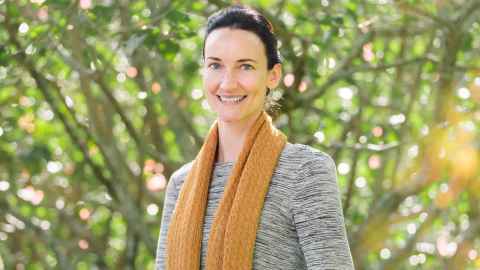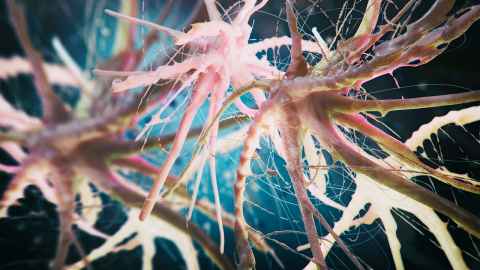The 150-year-old mystery disease killing two New Zealanders a week
29 April 2021
New Zealand has one of the world’s worst rates of a fatal brain disease. Now, scientists hunting rogue genes hope to unravel the 150-year-old mystery of what triggers the disease and how to find a cure.



Motor neuron disease is absurdly cruel and mysterious. Some niggly dysfunction may mark the onset; fatigue and an unexpected weakness in a limb or a struggle with pulling on socks or undoing a button.
A year may pass before diagnosis, with a creeping paralysis already underway. Death often comes in one to four years, as the disease kills motor neurons that control muscles, eventually making it impossible to walk, talk, swallow – or breathe. Stephen Hawking, the genius British physicist and author of A Brief History of Time, was an exceptionally long-lived sufferer, surviving more than 50 years after diagnosis. He could communicate through technology recognising his cheek twitches.
For now, drug treatments can only prolong life by a matter of months. New Zealanders with the disease include Auckland corporate lawyer Greg Horton – a mergers and acquisitions specialist and director of Emirates Team New Zealand – and Samarra Wright, a West Coaster, among as many as five generations of her family to suffer from the condition. Dozens of her relatives and forebears seem to have carried a faulty gene implicated in the disease. Rotorua woman and former world-class gymnast Kirsty Gerlach, now deceased, told Stuff in 2018: “It’s a frightful diagnosis, because they give you no hope whatsoever.’’
At any one time, 350 or more New Zealanders have the condition, which
kills about two people every week. Drugs available now can slow the disease’s
progress by months but cannot halt it. Experimental treatments hold promise.
In one study, in 2018, New Zealand had the world’s worst rate of the disease, with an estimated 2.8 cases per 100,000 people. Australia, the UK, Finland and Sweden are also up there, says Dr Emma Scotter, the head of the Motor Neuron Disease Lab at the University of Auckland’s Centre for Brain Research. North America, Western Europe and Australasia have high rates, while Africa and Asia are low, studies show.
Countries with emerging economies may be failing to detect all of their cases because of their health systems. Ancestry and genetic make-up also play a big role. Chinese people, for example, have low rates of a gene mutation called C9ORF72 that’s more prominent in European populations. Environmental differences are a wild card, since scientists don’t yet know which matter.
Now, Scotter and Dr Richard Roxburgh, a neurologist and neuro-geneticist at Auckland City Hospital and associate professor at the university, are running the first big study of the genetics of the disease in New Zealand. “We want to know if our high rates of the disease are because of high numbers of people with particular genetic mutations – or because of other factors,” she says.
Scotter wants to check for any potential unknown rogue genes and also work with Māori and Pacific cases and families to ensure they have equal access to genetic advances.
Three hundred people with the disease will donate blood or, in some cases, samples of skin tissue, over three years, with their DNA extracted at a Christchurch diagnostic laboratory and sent to Australia for gene sequencing. Previously, only a small minority of motor neuron disease patients have been tested – generally those with a clear family history of the disease.
Unlike, say, Huntington’s disease, which is caused by a single gene, over the past 30 years MND has been linked to no less than 35 rogue genes, and more are discovered every year. One of the most common globally is C9ORF72, another is SOD1. Scotter is guessing New Zealand’s most common problem genes may be largely the same as in the UK and Europe, given the ancestry of New Zealand Europeans.
However, she wants to check for any potential unknown rogue genes and also work with Māori and Pacific cases and families to ensure they have equal access to genetic advances. Already, researchers know that the most common gene mutations can differ across ethnic groups. “The same may be true for New Zealand Māori and Pasifika,” she speculates.

One long-term benefit of the study may be linking New Zealand patients with clinical drug trials. For example, a promising drug called Tofersen targets the SOD1 gene. In trials, injecting molecules of DNA into patients’ spinal fluid has effectively silenced their faulty SOD1 genes, reducing production of the toxic SOD1 protein implicated in their particular form of the disease. “The dream situation would be to have New Zealanders clinical-trial ready, but also, eventually, to have clinical trials in New Zealand,” Scotter says.
First described by the French neurologist Jean-Martin Charcot, motor neuron disease remains, in many ways, as mysterious as when Charcot discovered the disorder in 1869. In most cases where the disease is running through a family, a rogue gene can be identified. However, it's sometimes possible to carry the gene but not get the disease. And, in the majority of cases, no rogue gene can be identified.
Scientists believe environmental “insults” – such as exposures to toxicity – may act as triggers, with fewer of those negative events required for someone who’s already genetically susceptible. One theory, based on epidemiological studies, is that over a lifetime, six steps may be needed to develop the disease, with a rogue gene potentially accounting for two to four steps. The additional steps may come from environmental factors although as-yet-unknown gene mutations could also play a role.
The “steps” hypothesis fits with MND as an adult-onset condition – and accounts for why people can have a faulty gene but never develop the disease; they’ve taken steps down the path but never reached the destination. It seems possible that a series of environmental insults could account for the entire six steps, with no rogue gene required.
Trouble is, when it comes to environmental triggers, every workplace contains a cornucopia of potential toxins – and people are looking back at entire lifetimes and work histories. Suspicions have been cast at everything from pesticides and fumigants to toxic algal blooms in the water.
My children have a 50/50 chance of developing Motor Neuron Disease – I really want to advance the research as much as possible.”
In New Zealand, elevated risks of the disease have occurred for people working in an array of jobs, from fruit grower to construction worker to forecourt attendant, according to an epidemiological study published in the journal Occupational & Environmental Medicine in 2019.
“Once we know the underlying genetics, we may be able to interpret the plethora of environmental studies more accurately,” says Roxburgh. Know the genes and you know the biochemical pathways to focus on when looking for environmental effects.
Feilding mother-of-four Kylie Matena has already contributed her skin biopsy for the study. Half-Māori and half-European, she says motor neuron disease has run in the Māori side of her family, claiming her father, an aunt, an uncle, and a grandfather. Lower-body symptoms limit her walking and standing, fatigue is a problem, and she needs a ventilator at night and a cocktail of painkillers in the morning. The disease hasn’t prevented her from pursuing a Bachelor of Health Sciences extramurally and co-founding a business that helps disabled people manage their money.
“I’m really willing to do as much as I can to help with MND research and the MND community in general,” she says from Feilding. “My children have a 50/50 chance of developing MND – I really want to advance the research as much as possible.”
For Scotter, MND is a scientific challenge that became a personal passion. Mentored by one of New Zealand’s leading neuroscientists, Sir Richard Faull, she studied Huntington’s disease for her PhD. She got hooked on unravelling the mystery of motor neuron disease after post-doctoral work at King’s College, London with Professor Chris Shaw, a New Zealander who’s another neuroscience star, famed for his MND research.
Scotter started the MND lab in Auckland 2014 when she came back from the UK. Studies of human brain tissue are another big part of the lab’s work, using stains on brain tissue slices to determine if gene mutations cause clumping of their protein products in motor neurons and other types of cells.
“All neurological and neurodegenerative diseases are difficult, but there’s something particularly tough about motor neuron disease,” she says. “For most people it comes out of the blue; 95 per cent of people have no family history. Often, they’ll have a year of delay between symptoms and diagnosis. And that is precious time when motor neuron disease can leave people with only a few years to live.
“It’s just an awful disease – and it really caught me by the heart, I guess." Scotter is upbeat about the prospects for treatment. "Scientific research is growing an arsenal against neurodegenerative diseases and motor neuron disease is in the crosshairs. I am very hopeful for the future."
Story by Paul Panckhurst
Researcher portrait by Billy Wong
The Challenge is a continuing series from the University of Auckland about how our researchers are helping to tackle some of the world's biggest challenges.
To republish this article please contact: gilbert.wong@auckland.ac.nz